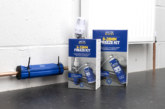How can housing providers ensure the heating systems in their stock comply with the updated BS 7593:2019, streamline compliance administration and reap the benefits without putting undue pressure on the process nor associated costs? Darran Burrage, National Specification Director at ADEY, puts forward a solution.
Last year, the revised BS 7593:2019 marked a step change in moving the industry towards a holistic approach to correct water treatment throughout the life of domestic heating and cooling systems. Over time, heating system water can contain a harmful build-up of sludge (black iron oxide), leading to poor water quality, which is the number one cause of boiler breakdowns. So starting with the prevention of sludge at the outset, to regularly monitoring water cleanliness and inhibitor levels, as well as long-term protection, the new guidelines ensure that the right water chemistry becomes an essential part of property maintenance.
Housing providers will need to carry out more work to comply with these new standards, however it presents an opportunity to improve processes on the ground and for records management. Reducing repair and servicing costs, potentially helping tenants to save energy and costs and ultimately, ensuring the warmth and comfort of tenants can all be achieved.
Raising the bar
Before BS 7593:2019 was updated, a chemical cleanse, followed by a fresh water flush and the addition of inhibitors, were only necessary at the commissioning stage. Filters were only deemed as ‘maybe beneficial’ as part of the flushing procedure, and regular monitoring was not prescribed.
The new British Standard states that, apart from a chemical clean, fresh water flush and the addition of an inhibitor at system commission, the concentration of additives in the water and its cleanliness have to be checked after commissioning, and annually thereafter, throughout the life of the system. Inhibitor should be re-dosed every five years or a full system water test undertaken. A permanent in-line filter should be fitted, and all the new procedures apply to both heating and cooling circuits. The increasing popularity of renewable solutions, which run on lower system temperatures, also mean that biocides are required for these solutions, and should be considered for higher temperature systems for added protection during downtime.
Testing inefficiencies
The introduction of regular water testing and redosing, recognises that chemical treatment is not a one-off procedure. Sludge and corrosion affect boilers from the moment they are commissioned and throughout the whole life of a heating system. With an estimated 1.8 billion boiler breakdowns occurring per year due to poor water quality, each costing an average of £270 to fix, housing providers with a portfolio of stock could end up spending thousands on repairs if water quality is not monitored and tested regularly to prevent the build-up of contaminants in the first place.
Those who do carry out water tests annually, in line with the new standards, probably find it a time-consuming process. Engineers have to visit a tenant’s property to take a water sample, which is then sent to a laboratory for in-depth testing, and wait for the results. Once these are received, the engineer must revisit the property if any element of the test requires corrective action. Dip testing is a common alternative to check water quality while on-site, but the limited results only measure the level of inhibitor in the system and are open to interpretation in regards to action required. In addition, records of on-site water tests and results have to be manually recorded. The absence of any connected technology deployed on the ground also means that there is no proof of where the water sample was taken.

Streamlining the process
The latest connected technology can help simplify this type of maintenance. The new ADEY ProCheck, for example, provides simple on-site analysis of water health in a heating system.
A maintenance engineer takes a water sample from the system water and carries out a dip test using the strips supplied with the kit. This strip is positioned on a test card before being scanned to the app using a smartphone camera — the scan is then analysed and verified. Much like a laboratory test, ADEY ProCheck looks specifically at the three main areas of concern: protective inhibitor levels, the level of corrosion through iron measurement and the dangers posed by the pH level present.
A report is immediately created and uploaded to a management portal, and the engineer can deal with quality issues identified there and then without the need for a second visit. The engineer’s work can be reviewed on the portal, and the valuable insights and trends offered by the test data across housing stock can be extracted and analysed by facility managers.
Opportunities to save
The new BS 7593:2019 has highlighted the need to take an end-to-end approach in treating water and maintaining its cleanliness throughout the life of heating and cooling systems. With the right technology, housing providers and their maintenance engineers have an opportunity to work more efficiently and effectively, whilst ensuring the optimum performance of domestic heating and cooling assets. Not only does this help tenants to reduce their energy bills and ensure they live in warmth and comfort, but also reduces the risk of breakdowns, to save social housing organisations time and money in the long run.









